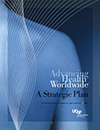- About
- Organization
- Organization Overview
- Dean’s Office
- Department of Bioengineering and Therapeutic Sciences
- Department of Clinical Pharmacy
- Department of Pharmaceutical Chemistry
- Quantitative Biosciences Institute
- Org Chart
- Research
- Education
- Patient Care
- People
- News
- Events
UCSF School of Pharmacy sets 5-year plan in motion
By UCSF School of Pharmacy Editorial Staff / Tue Apr 1, 2008

Strategic Course 2007-2012
"It is a plan that looks at today's medications and the needs of patients and lays out an agenda to meet those needs," says Mary Anne Koda-Kimble, PharmD, dean of the UCSF School of Pharmacy. She refers to the School's 5-year strategic plan Pressing Ahead in New Directions, which presents 3 interlocking goals—all focused on finding better ways to create drugs, use drugs, and improve health and save lives through drugs. The plan was released to the public on April 1, 2008.
Pressing Ahead in New Directions: Strategic Course 2007-2012
Our goals:
- Create a new framework for drug discovery and development
- Ensure that more patients get the best results from their drugs
- Shape the future of pharmacy science, policy, education, and patient care by working in fresh and collaborative ways
While the plan is ambitious, the School is well positioned to meet its goals, Koda-Kimble explains. "As academics, we explore and discover, rather than develop and sell. Our work gives industry the information it needs to make smarter drugs that ultimately improve the health of our patients. It fuels the basic and drug-related discoveries of other scientists worldwide. It reveals better ways for health care providers and patients to use drugs safely and effectively. It shows how behavior, economics, policies, and procedures affect a patient's health," she says.
She emphasizes that the School does not target its work on one disease exclusively. Rather, it focuses on laying the foundations that ultimately relate to the prevention and treatment of many diseases. In these ways, she explains, the UCSF School of Pharmacy is a powerful force for improving today's medications and their use.

Koda-Kimble stresses that while today's drugs have been key to longer and healthier lives, they will pale by comparison to tomorrow's therapeutics. "Today's drugs are quite crude compared to what we know is possible in the future. They are created in standard ways. They treat the non-existent 'average' person. They end up in many places in the body, not just where they are needed to do their jobs. They are expensive to develop and expensive to use. The ways in which we deliver pharmacy care to patients also don't meet the needs of our patients, whose situations are always shifting based upon income, life situation, and health status," she says.
Koda-Kimble sees this situation change and the UCSF School of Pharmacy as a pivotal player in what she predicts will be a transformation in pharmaceutical science and pharmacy care. She poses a number of scenarios in the School's strategic plan, such as:
- What if we had a deeper understanding of the biological and chemical process that give rise to disease?
- What if we developed better ways to identify how and why medication errors and adverse events occur in hospitals and in the community?
The answers to these and other questions form the basis of the plan and its 3 goals, which were developed and endorsed by the School's faculty in consultation with the School's students, staff, alumni leaders, and external advisors, and with counsel from UCSF campus leaders.

Measures of success in science
UCSF School of Pharmacy Faculty members:
- Created the field of rational drug discovery, a process that combines computers, physics-based models, and computer graphics with knowledge of protein structures to accelerate drug discovery.
- First described the concept of drug clearance, which is key to understanding how much drug is active in the body at a given time and to determining the most effective dose for a patient.
- Invented processes to manufacture nanosized drug delivery containers called liposomes, one of the first successful nanomedicines, approved by the United States Food and Drug Administration.
- Are leading the field of pharmacogenetics of membrane transporters to understand how drugs enter cells in the body, and how genetic variations cause a drug to affect different people in different ways.
- Are experts in protein science and the use of computation and computer modeling to understand biology and disease.
Goal #1: Create a new framework for drug discovery and development
A major portion of the School's work will focus on creating a new framework for drug discovery and development through basic science research and research that takes fundamental discoveries and translates them into new therapeutics. To do this, School scientists will amplify their expertise in chemistry, mathematics, and physics—through new faculty recruitments and new research programs—to learn more about the biology of health and disease. They will create new tools, including those on the nanoscale, to poke and probe living systems, and in doing so understand how to better diagnose and treat disease. And they will expand their use of nontraditional approaches to predict which drugs will work best in, or even harm, individual patients or populations.
"The deepest problem today in discovering new medicines is that our concepts and approaches are too simplified and limited," says Ken Dill, PhD, associate dean for research at the UCSF School of Pharmacy. "In addition, we're finding that more and more disease mechanisms don't fit the standard single protein, single binding site paradigm in drug discovery. In other words, there is more to stopping some diseases than simply inserting a chemical key into a problem molecule and locking its function."
Dill and his research faculty colleagues in the School believe that key wellsprings for advances in drug discovery are to be found in the deepest reaches of basic research science. While the pharmaceutical and biotechnology industries spend their resources applying today's methods to discovering tomorrow's drugs, UCSF School of Pharmacy researchers focus on inventing tomorrow's methods of drug discovery.
"The drug industry has increasingly shifted its emphasis downstream from discovery toward product development, ceding ever more of the underlying basic research on new approaches and technologies to academic centers," says Dill. "This School is an academic center of accomplishment in the pharmaceutical sciences. We thrive on science challenges, and with the new plan we are continuing to flourish," he adds.

Measures of success in clinical pharmacy and health policy
UCSF School of Pharmacy Faculty:
- Created the field of clinical pharmacy. In this model, pharmacists work side by side with physicians and nurses and care for patients directly.
- Demonstrated the value of antimicrobial prescription-monitoring programs in hospitals which have now developed into national models to improve the treatment of hospital-associated infections.
- Developed the Center for Consumer Self Care to empower consumers take a central part in caring for their own health with the ultimate goal of better health outcomes in our communities.
- Through analysis of tobacco industry research sponsorship and business practices, revealed that the tobacco industry was aware of the health hazards and addictive properties of cigarettes.
Goal #2: Ensure that more patients get the best results from their drugs
Against a backdrop of successful science and current innovation that will lead to more effective drugs with few or no side effects, UCSF School of Pharmacy faculty members are studying how to make sure more patients get the best results from the drugs they use. To the School's faculty, this means designing better clinical drug trials, new ways for pharmacists to care for patients, and new ways to decrease the medication errors that can jeopardize a patient's health and life. It also means empowering patients to better understand their own health conditions and medications and meeting the pharmacy needs of the world's underserved.
For Joseph Guglielmo, PharmD, chair of the School's department of clinical pharmacy, one line stands out in the School's strategic plan: "Take a pill and everything will be fine…if only it were that easy."
"'The relationship between any one drug and a patient is usually impersonal, sometimes volatile and inconsistent, and always complicated," explains Guglielmo.
Today's drugs do not consider the genetic differences in drug response among patients. Some cause mild to serious to life-threatening side effects. Drug effectiveness can be altered by such things as diet or exercise. And medications end up throughout the body, not just where they are needed to do their work.
"Pharmacists are the only health care providers trained to master the thousands of medications on the market. They are the drug experts. They all graduate as clinicians with Doctor of Pharmacy (PharmD) degrees, and in our School most go on to complete residency training," says Guglielmo. That kind of intellectual rigor is essential, he explains, especially for academic pharmacists, such as those in the UCSF School of Pharmacy, who teach pharmacy students, practice pharmacy themselves, and conduct the research from which changes in pharmacy care evolve worldwide.
"In addition to pharmacy clinicians, we're fortunate to have on our faculty exceptional health policy, health economics, and health care decision-making experts," says Guglielmo. The interface between the patient and the pill, he explains, has a lot to do not only with the patient's situation but with the situations in Washington, DC and in the public sector as well.
"In order to ensure that more patients get the best results from their drugs, we have to consider it all—the patient, pill, medication care and delivery process, and the politics. Our research covers the full spectrum." One objective of the new plan is to develop a Medication Outcomes Research Center to study the effective and safe use of medications in the UCSF Medical Center and develop new models of excellence for the Medical Center and others, says Guglielmo.

Goal #3: Shape the future of pharmacy science, policy, education, and patient care by working in fresh and collaborative ways
"As we determined where we were headed through 2012, it became clear that we had to work in new ways to get there," says Koda-Kimble. "This, then, was the third goal of our plan. Our faculty members have traditionally worked across academic fields, and now we're combining fields in new ways. We're polishing a program to prepare more pharmacists to pursue research. Our students are teaching their peers—students in medicine and nursing. Their leadership across the board is stunning. Our faculty and students are sharing their expertise with our global neighbors from Vietnam to Malawi and learning just as much or more about themselves and their work in exchange."
The School is also formalizing its commitment to diversity as part of its new strategic plan. The document describes diversity as that not only of people, but of perspectives, experiences, and academic and professional disciplines. "Science flourishes, healing is more likely to occur, and learning is enriched in a School community that is diverse in all ways," says Koda-Kimble. "We are especially committed to helping historically underrepresented minorities succeed."
Ongoing mission
Koda-Kimble calls attention to the fact that while the School moves forward to accomplish the 3 goals outlined in its new strategic plan, it remains focused at all times on meeting its mission, which also includes:
- Educating PharmD students as leaders and experts in the safe and effective use of medicines.
- Educating PhD graduate students to be outstanding researchers across the spectrum from the basic to the health sciences.
- Providing strong postdoctoral training.
School and campus plans align
While planning for Pressing Ahead in New Directions was under way, the UCSF campus began its first-ever strategic planning process, which included a redrafting of the campus mission statement. "As result, we in the School of Pharmacy slowed our planning timeline and participated in both campus and School planning. Our plan, Pressing Ahead in New Directions, and the campus plan, Advancing Health Worldwide, are in sync—as they must be," explains Koda-Kimble.
Plan affects many
"Our plan was a long time in the making, concise in its final form, complementary to the campus plan, and we believe inspirational and hopeful to anyone who has ever used a medication—and that is just about all of us," she says.
More
School Plan

Pressing Ahead in New Directions: Strategic Course 2007-2012
Campus Plan

Advancing Health Worldwide: A Strategic Plan
Tags
Category:
Sites:
School of Pharmacy, Department of Pharmaceutical Chemistry, Department of Bioengineering and Therapeutic Sciences, Department of Clinical Pharmacy, PharmD Degree Program, Dean's Office
About the School: The UCSF School of Pharmacy aims to solve the most pressing health care problems and strives to ensure that each patient receives the safest, most effective treatments. Our discoveries seed the development of novel therapies, and our researchers consistently lead the nation in NIH funding. The School’s doctor of pharmacy (PharmD) degree program, with its unique emphasis on scientific thinking, prepares students to be critical thinkers and leaders in their field.




